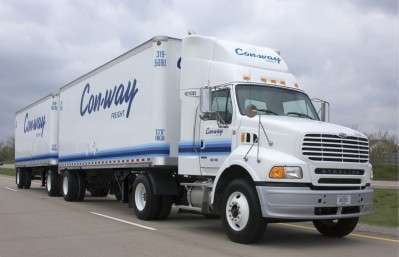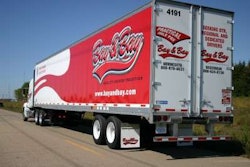 IVBSS uses information gathered by inertial, video and radar sensors, plus a global positioning system, to warn drivers of potentially dangerous situations to prevent or lessen the severity of crashes.
IVBSS uses information gathered by inertial, video and radar sensors, plus a global positioning system, to warn drivers of potentially dangerous situations to prevent or lessen the severity of crashes.About two years ago, the University of Michigan Transportation Research Institute embarked on a four-year Integrated Vehicle-Based Safety System (IVBSS) program through a cooperative agreement with the U.S. Department of Transportation.
The IVBSS program involves researching, developing and the verification testing of a fully integrated safety system with multiple crash warning features – forward collision, lane departure and lane change/merge warning – in a platform for commercial trucks.
From the beginning, the institute had a commercial fleet that was willing to invest significant time and resources to make the program a success. About a mile away from the university’s campus in Ann Arbor, Mich., a less-than-truckload carrier stepped forward from the start to offer an attractive model for testing.
“We volunteered to participate in this project since safety is one of Con-way Freight’s core values, and we expect this type of technology to figure prominently in future safety initiatives in the transportation industry,” says Robert Petrancosta, the company’s vice president of safety.
Like many LTL carriers, Con-way Freight runs its tractors 24 hours a day. One set of drivers makes pickups and deliveries during the day in a city environment. A separate driver crew operates the tractors in line haul during the evening and night.
“It is a nice dynamic – the best of both worlds for the study,” Petrancosta says. Recently, the project reached a new stage as Con-way Freight began the field-operational testing of the integrated system in 10 of its own vehicles.
Involved from the start
The IVBSS program is designed to provide drivers with situational awareness of the vehicle’s surroundings. It warns drivers when they are about to leave the roadway inadvertently, are in danger of colliding with another vehicle while attempting a lane change, or are at risk of colliding with the vehicle ahead.
The types of incidents that IVBSS is designed to prevent – front collision, side collision and moving out of the lane unintentionally – account for 2.6 million accidents on the highway each year for all vehicles, Petrancosta says. Studies have found that vehicles equipped with driver warning devices can reduce the number of accidents by two-thirds, he says.
The types of accidents the IVBSS system can help prevent also happen to be the top three accidents in terms of frequency at Con-way Freight. Backing accidents are the only high-risk accident the system does not identify, Petrancosta says.
“It doesn’t take a rocket scientist to know that there are not many field tests that can have this kind of impact on safety,” he says.
Con-way Freight has prior experience testing driver and vehicle safety systems nearly identical to the separate systems that are used by IVBSS. The main difference is that Con-way Freight always has tested the technologies independently, not as part of an integrated platform. After each test, the company walked away from the technologies due to reliability concerns, Petrancosta says.
“At some point, the driver does not feel comfortable with the alert he is getting,” he says. “You just can’t have that.”
Getting the bugs out
Petrancosta says vehicle safety systems have improved since Con-way Freight tested the early versions. During the past 18 months of participating with the IVBSS program, Con-way Freight has worked closely with the university to get the system to a point where it is “working well and working all the time.”
As part of an extended pilot test over a four-week period, seven different Con-way Freight drivers drove a company test vehicle with the IVBSS system installed. All drivers that participated in the extended test pilots generally were favorable toward the technology, says Petrancosta, who worked closely with the university to fine-tune the system before the full-fledged field-operational testing began.
“Extended test pilot results proved that drivers felt very comfortable and could prioritize what the reaction should be,” he says. “One of my concerns is how intuitive it would be. Would it be more confusing? That hasn’t been the case.”
Petrancosta said the test pilots provided the necessary data to make tweaks to reduce the error rate. “They’ve done very good,” he says. “The University of Michigan has done a fantastic job, as have all the vendors, in getting false warnings down to bare minimum. Now the confidence level is greater for this technology.”
Awaiting results
As part of the second phase of the four-year IVBSS program, Con-Way Freight recently began field testing the technology on the road under normal, naturalistic conditions.
“After more than two years of research, development and verification testing of the integrated system, it’s gratifying to see the system functioning as part of Con-way Freight’s fleet,” says Jim Sayer, program director and UMTRI researcher. “We are optimistic that the testing will demonstrate the safety benefits of integrating multiple crash warning systems.”
To conduct the field tests, Con-way Freight invested about $750,000 of its own money to purchase 10 new Class 8 tractors. Over the course of the next 10 months, 20 Con-way Freight truck drivers will operate the trucks out of the company’s Detroit service center with the IVBSS installed as part of normal business operations. The trucks will log an estimated 700,000 miles – the equivalent of eight years of driving experience, Petrancosta says.
As part of the field test, data on driver response to IVBSS will be recorded along with extensive data collection on naturalistic use and driving conditions. Cameras are mounted inside and outside the test vehicle to record driver behavioral data. When the system sends alert signals, the cameras will record instantaneously.
Con-way Freight made driver participation in the program strictly voluntary. No data is being shared with the company on any individual driver’s behavior. As part of the program, Con-way Freight only will receive driver behavioral data on a cumulative basis.
The field testing not only demonstrates the evolution of safety technology, but also the data that comes from the study that can be used for many other purposes, such as to better understand driving behaviors, Petrancosta says.
In addition to Con-way Freight, program partners for the IVBSS commercial-truck research include Eaton Corp., TK Holdings, International Truck and Engine Corp. and Battelle. The cooperative agreement is with USDOT and is administered by the National Highway Traffic Safety Administration, with assistance from the Federal Motor Carrier Safety Administration.
Program funding for IVBSS is provided by USDOT’s Research and Innovative Technology Administration. For more information about the IVBSS program, go to www.its.dot.gov/ivbss.
Although the field tests have just started, the early results for Con-way Freight have been encouraging, Petrancosta says. On one occasion, the data revealed that one lane departure alert occurred because a driver was starting to doze off. “The system worked perfectly,” he says. “The driver drove without incident the rest of the way.”











